In This Article Show
For over 13 years, I’ve had the pleasure of getting my hands dirty, experimenting with plants, and learning the ins and outs of a thriving garden. If there’s one herb that has consistently found its way into my garden plots, it’s thyme. Not only is this aromatic wonder a kitchen staple, but it also plays well with others. I’m talking about the age-old practice of companion planting.
Companion planting, for those who might be new to the term, is essentially the gardening technique of pairing plants that benefit one another. Some plants deter pests for their neighbors, while others share nutrients or simply help one another grow better. Thyme, as it turns out, has quite the entourage of plant pals that love its company.
In this post, I’ll share a comprehensive list of thyme’s best buddies – those plants that flourish alongside it. Whether you’re a seasoned gardener or just starting out, this guide will offer insights to boost the harmony and productivity of your garden space. Let’s dive in!
The Benefits of Companion Planting with Thyme
In my 13 years of gardening, I’ve come to recognize that not all plants are solitary creatures. Just like us, they thrive better in the company of good friends. Thyme, in particular, brings some impressive benefits to the table when it comes to companion planting:
1. Pest Control
One of the standout virtues of thyme is its natural ability to repel pests. Many garden critters don’t fancy the strong scent of thyme, which means having it around can reduce the need for chemical pesticides.
This herb acts as a sentinel, guarding its neighboring plants from pests like cabbage worms and whiteflies. So, when you’re planting thyme alongside susceptible plants, you’re essentially giving them a protective shield.
Get Gardening For Beginners
Our new EBOOK shows newcomers and green thumbs alike a step by step guide to growing the garden of their dreams.
2. Soil Enrichment and Nutrient Sharing
Plants communicate and share in ways we’re only just beginning to understand. Certain companion plants, thyme included, can help improve the quality of the soil they grow in. They can aid in nutrient retention, ensuring that the plants growing nearby have access to the essential elements they need to flourish.
3. Mutual Growth Enhancement
Now, this is where the magic happens! Some plants, when grown together, just seem to make each other better. Thyme has been known to improve the growth of many plants, especially when it comes to flavor profiles. If you’ve ever wondered why your tomatoes taste extraordinarily delicious after planting them near thyme, it’s not just a coincidence.
To put it simply, thyme doesn’t just coexist with its plant companions—it helps them thrive. As we delve deeper into our list of thyme’s best companions, you’ll see firsthand how this herb can be a game-changer in the garden. Whether it’s deterring pests, enhancing soil, or boosting flavors, thyme proves that a little companionship can go a long way.
Best Companion Plants for Thyme
Thyme’s aromatic presence and resilient nature make it a desirable companion in the garden. Its allies not only enjoy protection from certain pests but often reap other growth and flavor benefits. Let’s explore some of the top plants that truly benefit from being paired with thyme:
1. Strawberries

This fruitful pairing is a favorite of many gardeners. Planting thyme alongside strawberries not only deters certain pests but also seems to enhance the flavor of the berries. There’s something about the aromatic profile of thyme that makes strawberries taste even sweeter and juicier.
2. Roses

An unconventional pairing, perhaps, but a beneficial one nonetheless. Roses and thyme together can create a stunning visual display in any garden. More importantly, thyme helps deter aphids, one of the common pests that rose plants often grapple with. This means healthier roses with fewer chemical interventions.
3. Cabbage

Cabbage plants often attract a host of pests, with cabbage worms being one of the most notorious. Thyme, with its pest-repelling properties, acts as a natural barrier. The strong scent of thyme confuses and deters these pests, ensuring that your cabbages remain hole-free and healthy.
Get Gardening For Beginners
Our new EBOOK shows newcomers and green thumbs alike a step by step guide to growing the garden of their dreams.
4. Tomatoes

This classic pairing is both functional and flavorful. Tomatoes and thyme go hand in hand not just in culinary dishes but also in the garden. Thyme helps in repelling certain pests that often target tomato plants. Additionally, many gardeners swear by an improved tomato flavor when these two are planted in proximity.
5. Eggplant

Another member of the nightshade family, eggplants, or aubergines, can benefit greatly from thyme’s companionship. Apart from mutual growth enhancement, the duo together can discourage pests that commonly target eggplants.
6. Brassicas

Broccoli, Brussels sprouts, and cauliflower are all part of the Brassica family. These veggies, when planted near thyme, can benefit from its pest-repelling properties. The strong aroma of thyme can deter pests like aphids and cabbage loopers that often target Brassicas.
7. Lettuce and Greens

Leafy greens such as lettuce, spinach, and kale can thrive alongside thyme. The herb helps to ward off slugs and snails, common nuisances for these plants. Furthermore, thyme may enhance the flavor profile of these greens when grown nearby.
8. Onions and Garlic

Both onions and garlic can benefit from thyme’s ability to repel certain pests. Thyme’s strong scent can mask the smell of these alliums, making it harder for pests to locate them. Additionally, the plants have complementary root depths, allowing them to coexist without competing for nutrients.
9. Potatoes

Another member of the nightshade family, potatoes can similarly benefit from thyme as tomatoes and eggplants. Thyme can help deter potato beetles and enhance harvested potatoes’ flavor.
10. Peppers

These plants can flourish alongside thyme, Whether bell peppers or hot chili peppers. The herb can deter some common pests like aphids and whiteflies. Plus, the aromatic presence of thyme might subtly influence the flavor of peppers, making them even more delicious.
Incorporating thyme into your garden plots alongside these plants can make a world of difference. It’s about deterring pests and creating a holistic environment where plants can grow to their full potential. As we move along, we’ll also explore other plants that are compatible with thyme and a few that you might want to keep a distance from.
Plants to Avoid Planting with Thyme
While thyme plays nicely with a wide array of plants, there are a few with which it doesn’t quite gel. Just like in any community, sometimes certain members don’t see eye to eye. Here’s a list of plants you might want to keep at a distance from your thyme:
1. Mint
At first glance, mint and thyme might seem like natural bedfellows, given their aromatic natures. However, mint is an aggressive grower and can quickly overpower the more sedate thyme, competing for resources and space. Additionally, they attract different sets of insects, and pairing them might lead to a pest imbalance in your garden.
2. Fennel
Another strong-scented herb, fennel doesn’t play well with many plants, and thyme is no exception. Fennel tends to inhibit the growth of plants around it, and its strong aroma might overpower that of thyme. It’s best to give the fennel its own space in the garden.
3. Corn
While not inherently antagonistic, corn and thyme have different growth needs and watering requirements. Corn tends to require more water and might make the surrounding soil too damp for thyme, which prefers well-drained soil.
4. Grapes
If you happen to be growing grapevines, it’s a good idea to keep them away from thyme. Both plants are susceptible to similar fungal diseases, and planting them close together might exacerbate the issue.
5. Cucumbers
Thyme and cucumbers don’t have a strong antagonistic relationship, but they don’t particularly benefit from each other either. Given thyme’s potential to attract certain insects, it’s best to separate them to ensure that cucumber plants remain as pest-free as possible.
In gardening, as in life, understanding which relationships work and which don’t can be the key to a harmonious existence. While thyme gets along with most, paying attention to these few exceptions can ensure that all your plants have the best chance to thrive.
Tips for Successful Companion Planting
Companion planting isn’t just about knowing which plants go well together; it’s also about understanding how to create an environment where these beneficial relationships can truly flourish. Here are some pointers to make the most of your thyme companion planting:
1. Proper Spacing
While it’s good for companion plants to be close, they mustn’t be overcrowded. Ensure that thyme and its companions have enough space to grow without competing for sunlight and nutrients. Generally, thyme plants should be spaced about 8-12 inches apart, but always check the specific requirements of the companion plants as well.
2. Soil Health
Even the best of plant buddies won’t thrive if the soil isn’t up to par. Thyme prefers well-drained soil with a neutral to slightly alkaline pH. Before planting, consider testing your soil’s pH and amending it if needed. Also, remember to mix in some organic compost to give your plants a nutrient-rich start.
3. Watering Wisely
Thyme is drought-resistant and doesn’t need frequent watering. Make sure you’re not over-watering, especially if its companions have similar water requirements. A good rule of thumb: water when the soil feels dry an inch below the surface.
4. Monitoring for Pests
Even though thyme is a natural pest deterrent, it’s always a good idea to keep an eye out for any potential infestations. If you do spot pests, try to address them using natural remedies before resorting to chemicals. This keeps the garden ecosystem balanced.
5. Rotate Crops Annually
Crop rotation isn’t just for big farms. By changing the location of your plants each year, you can help prevent soil-borne diseases and pests from becoming a recurring problem. This also ensures that the soil nutrients remain balanced.
6. Mulch Around the Base
Mulching can help retain soil moisture, suppress weeds, and regulate soil temperature. Using organic mulch around thyme and its companions can also add nutrients back into the soil as it decomposes.
7. Experiment and Observe
Every garden is unique. While there are general guidelines and proven companions for thyme, it’s essential to observe how plants interact in your specific environment. Take notes, adjust, and experiment to find the best combinations for your garden.
Companion planting is as much an art as it is a science. With a little patience, observation, and these tips in hand, you’ll be well on your way to creating a garden where thyme and its companions thrive in harmony.
Conclusion
Companion planting offers a natural, holistic approach to gardening, enhancing growth, flavor, and overall health. While thyme makes a valuable ally to many plants, understanding its specific relationships is key.
By pairing it wisely and following some basic gardening tips, you can maximize the benefits of this aromatic herb.










